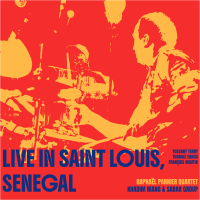Home » History of Jazz Timeline: 1958
History of Jazz Timeline: 1958
Ornette Coleman makes his recording debut for Contemporary.
Ornette Coleman records the influential LP Something Else! in February. This album features Ornette on alto sax, Don Cherry on trumpet, Don Payne on bass, Walter Norris on piano and Billy Higgins on drums. This album is available on OJC.
Cannonball Adderley records the excellent LP Somethin' Else a month later. This album features Cannonball on alto, Miles Davis on trumpet, Hank Jones on piano, Sam Jones on bass and Art Blakey on drums. This album is available on Blue Note.
Coltrane records Soultrane, Black Pearls and Settin' the Pace for
Prestige (reissued on OJC). Black Pearls documents some of his most heated
"sheets of sound" playing to date. At the end of 1958, Coltrane leaves Prestige and signs a
two-year contract with Atlantic Records.
Miles Davis brings pianist Bill Evans into his group.
The new Miles Davis group, featuring Coltrane, records Milestones in April. This recording represents a significant shift toward modal jazz.
On December 15, pianist Bill Evans records the unaccompanied piano solo Peace Piece on which he improvises two repeated chords. What makes this recording significance is that Evans draws heavily on George Russell's modal theory. It's one of the first examples of modes in modern Jazz.
Pianist Bill Evans records Everybody Digs Bill Evans with Sam Jones on bass and
Philly Joe Jones on drums. This album, which contains the innovative Peace Piece,
is available on Original Jazz Classics. I hope that Bill didn't come up with this title! ... Just
kidding. Riverside came up with the title to promote Bill in the ranks of Jazz. The cover is a
unique "all quotes" design featuring complimentary blurbs from various people including
Miles Davis, the first time the trumpeter allowed himself to be quoted in such a manner
about a fellow musician.
Bill Evans is chosen "New Star" pianist in the Downbeat International Jazz Critics Poll.
Thelonious Monk begins an association with saxophonist Charlie Rouse that lasts until
1970.
Trumpeter Lee Morgan is now with Art Blakey and the Jazz Messengers.
Eric Dolphy joins the Chico Hamilton Quintet.
Sax player Benny Golson is now with Art Blakey and the Jazz Messengers for a short while.
Sax player Tina Brooks records as a leader for Blue Note.
Pianist Cecil Taylor plays the Great South Bay Festival with a group that includes Buell Neidlinger on bass, Steve Lacy on soprano saxophone and Dennis Charles on drums. Nat Hentoff gives them a good review. The resulting publicity gets Taylor a recording date with United Artists which results in the LP Love for Sale. Taylor will later go completely into Free Jazz and will gradually decline.
Soprano saxophone virtuoso Sidney Bechet is rolling at the Brussels World's Fair Concert. His performance can be heard on Vogue.
Ellington performs at Carnegie Hall with Ella Fitzgerald and he wins the Downbeat Critic's poll and the Downbeat poll for composing.
Mahalia Jackson sings at the Newport Festival.
Bop composer and arranger Tadd Dameron enters the Federal Narcotics Hospital in Lexington, Kentucky for his heroin addiction. Had it not been for his drug addiction, many feel that Dameron could have been the Ellington of Bop.
Early in the year, British-born singer Annie Ross joins Dave Lambert and Jon Hendricks to
form the Pop-Vocalese singing group Lambert, Hendricks and Ross. They record the
experimental Sing a Song of Basie. It is a success.
Art Kane's photo of 57 Jazz greats on the steps of a Harlem Brownstone appears in Esquire
magazine. Some of the legendary musicians who showed up for the 10:00 a.m. photo
shoot were: Thelonious Monk, Lester Young, Count Basie, Dizzy Gillespie, Roy Eldridge,
Gerry Mulligan, Sonny Rollins, Art Blakey, Milt Hinton and Art Farmer.
Ike Turner discovers Anna Mae Bullock in East St Louis, renames her Tina and begins to explore Soul and Funk.
 AAJ Building a Jazz Library: Masterpieces
Art Blakey & The Jazz Messengers - Moanin'
Jazz's most explosive drummer debuted his third version of the Jazz
Messengers with this instant hard-bop classic. It's way too funky in
here, thanks to compositions and performances by Benny Golson, Lee
Morgan and Bobby Timmons (who contributed the famous title track).
AAJ Building a Jazz Library: Masterpieces
Art Blakey & The Jazz Messengers - Moanin'
Jazz's most explosive drummer debuted his third version of the Jazz
Messengers with this instant hard-bop classic. It's way too funky in
here, thanks to compositions and performances by Benny Golson, Lee
Morgan and Bobby Timmons (who contributed the famous title track).
 AAJ Building a Jazz Library: Masterpieces
Jimmy Smith - The Sermon
A foreshadowing of Smith's awesome Back at the Chicken Shack
and Midnight Special, and defining moment of organ jazz. Smith,
Lee Morgan and Curtis Fuller testify on the side-long title track.
AAJ Building a Jazz Library: Masterpieces
Jimmy Smith - The Sermon
A foreshadowing of Smith's awesome Back at the Chicken Shack
and Midnight Special, and defining moment of organ jazz. Smith,
Lee Morgan and Curtis Fuller testify on the side-long title track.
Keyword Search
Disclaimer: Though we have checked our facts, this timeline may contain erroneous information. If you discover errors or omissions, please bring them to our attention.









